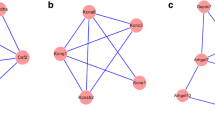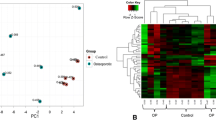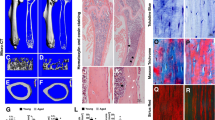Abstract
Vitamin A is the only known compound that produces spontaneous fractures in rats. In an effort to resolve the molecular mechanism behind this effect, we fed young male rats high doses of vitamin A and performed microarray analysis of diaphyseal bone with and without marrow after 1 week, i.e., just before the first fractures appeared. Of the differentially expressed genes in cortical bone, including marrow, 98% were upregulated. In contrast, hypervitaminotic cortical bone without marrow showed reduced expression of 37% of differentially expressed genes. Gene ontology (GO) analysis revealed that only samples containing bone marrow were associated with a GO term, which principally represented extracellular matrix. This is consistent with the histological findings of increased endosteal/marrow osteoblast number. Fourteen genes, including Cyp26b1, which is known to be upregulated by vitamin A, were selected and verified by real-time PCR. In addition, immunohistochemical staining of bone sections confirmed that the bone-specific molecule osteoadherin was upregulated. Further analysis of the major gene-expression changes revealed apparent augmented Wnt signaling in the sample containing bone marrow but reduced Wnt signaling in cortical bone. Moreover, induced expression of hypoxia-associated genes was found only in samples containing bone marrow. Together, these results highlight the importance of compartment-specific analysis of bone and corroborate previous observations of compartment-specific effects of vitamin A, with reduced activity in cortical bone but increased activity in the endosteal/marrow compartment. We specifically identify potential key osteoblast-, Wnt signaling-, and hypoxia-associated genes in the processes leading to spontaneous fractures.



Similar content being viewed by others
References
Collazo J, Rodriguez J (1933) Hypervitaminose II, exophtalmus und spontanfrakturen. Klin Wochschr 12:1768–1771
Bomskov C, Seeman G (1933) Uber eine wirkung des vitamin A auf den mineralhaushalt. Z Ges Exp Med 89:771–779
Strauss K (1934) Beobachtungen bei hypervitaminose A. Anat U Allgem Pathol 94:345–352
Moore T, Wang YL (1945) Hypervitaminosis A. Biochem J 39:222–228
Nieman C, Obbink H (1954) The biochemistry and pathology of hypervitaminosis A. Vitam Horm 12:69–99
Rodahl K (1950) Hypervitaminosis in the rat. J Nutr 41:399–421
Johansson S, Lind PM, Hakansson H, Oxlund H, Orberg J et al (2002) Subclinical hypervitaminosis A causes fragile bones in rats. Bone 31:685–689
Hixson EJ, Burdeshaw JA, Denine EP, Harrison SD Jr (1979) Comparative subchronic toxicity of all-trans- and 13-cis-retinoic acid in Sprague-Dawley rats. Toxicol Appl Pharmacol 47:359–365
Kurtz PJ, Emmerling DC, Donofrio DJ (1984) Subchronic toxicity of all-trans-retinoic acid and retinylidene dimedone in Sprague-Dawley rats. Toxicology 30:115–124
Forsyth KS, Watson RR, Gensler HL (1989) Osteotoxicity after chronic dietary administration of 13-cis-retinoic acid, retinyl palmitate or selenium in mice exposed to tumor initiation and promotion. Life Sci 45:2149–2156
Teelmann K (1981) Experimental toxicology of the aromatic retinoid Ro 10-9359 (Etretinate). In: Orfanos C, Braun-Falco O, Farber E, Grupper C, Polano M, Schuppli R (eds) Retinoids: advances in basic research and therapy. Springer-Verlag, Berlin, pp 41–47
Kneissel M, Studer A, Cortesi R, Susa M (2005) Retinoid-induced bone thinning is caused by subperiosteal osteoclast activity in adult rodents. Bone 36:202–214
Lind T, Lind PM, Jacobson A, Hu L, Sundqvist A et al (2011) High dietary intake of retinol leads to bone marrow hypoxia and diaphyseal endosteal mineralization in rats. Bone 48:496–506
Li C, Wong WH (2001) Model-based analysis of oligonucleotide arrays: expression index computation and outlier detection. Proc Natl Acad Sci USA 98:31–36
Irizarry RA, Hobbs B, Collin F, Beazer-Barclay YD, Antonellis KJ et al (2003) Exploration, normalization, and summaries of high density oligonucleotide array probe level data. Biostatistics 4:249–264
Smyth GK (2004) Linear models and empirical Bayes methods for assessing differential expression in microarray experiments. Stat Appl Genet Mol Biol 3: Article3
Smyth GK (2005) Limma: linear models for microarray data. In: Gentleman R, Carey V, Dudoit S, Irizarry R, Huber W (eds) Bioinformatics and computational biology solutions using R and bioconductor. Springer, New York, pp 397–420
Benjamini Y, Hochberg Y (1995) Controlling the false discovery rate: a practical and powerful approach to multiple testing. J R Stat Soc B 57:289–300
Huang DW, Sherman BT, Lempicki RA (2009) Systematic and integrative analysis of large gene lists using DAVID Bioinformatics Resources. Nat Protoc 4:44–57
Dennis G Jr, Sherman BT, Hosack DA, Yang J, Gao W et al (2003) DAVID: database for annotation, visualization, and integrated discovery. Genome Biol 4:P3
Hollberg K, Hultenby K, Hayman A, Cox T, Andersson G (2002) Osteoclasts from mice deficient in tartrate-resistant acid phosphatase have altered ruffled borders and disturbed intracellular vesicular transport. Exp Cell Res 279:227–238
Wendel M, Sommarin Y, Heinegård D (1998) Bone matrix proteins: isolation and characterization of a novel cell-binding keratan sulfate proteoglycan (osteoadherin) from bovine bone. J Cell Biol 141:839–847
Kamiya N, Kaartinen VM, Mishina Y (2011) Loss-of-function of ACVR1 in osteoblasts increases bone mass and activates canonical Wnt signaling through suppression of Wnt inhibitors SOST and DKK1. Biochem Biophys Res Commun 414:326–330
Zhao X, Brade T, Cunningham TJ, Duester G (2010) Retinoic acid controls expression of tissue remodeling genes Hmgn1 and Fgf18 at the digit–interdigit junction. Dev Dyn 239:665–671
Shimono K, Tung WE, Macolino C, Chi AH, Didizian JH et al (2011) Potent inhibition of heterotopic ossification by nuclear retinoic acid receptor-γ agonists. Nat Med 17:454–460
Bonewald LF (2011) The amazing osteocyte. J Bone Miner Res 26:229–238
Easwaran V, Pishvaian M, Salimuddin, Byers S (1999) Cross-regulation of beta-catenin-LEF/TCF and retinoid signaling pathways. Curr Biol 9:1415–1418
Engberg N, Kahn M, Petersen DR, Hansson M, Serup P (2010) Retinoic acid synthesis promotes development of neural progenitors from mouse embryonic stem cells by suppressing endogenous, Wnt-dependent nodal signaling. Stem Cells 28:1498–1509
Kato M, Patel MS, Levasseur R, Lobov I, Chang BH et al (2002) Cbfa1-independent decrease in osteoblast proliferation, osteopenia, and persistent embryonic eye vascularization in mice deficient in Lrp5, a Wnt coreceptor. J Cell Biol 157:303–314
Fujino T, Asaba H, Kang MJ, Ikeda Y, Sone H et al (2003) Low-density lipoprotein receptor-related protein 5 (LRP5) is essential for normal cholesterol metabolism and glucose-induced insulin secretion. Proc Natl Acad Sci USA 100:229–234
Kramer I, Halleux C, Keller H, Pegurri M, Gooi JH et al (2010) Osteocyte Wnt/beta-catenin signaling is required for normal bone homeostasis. Mol Cell Biol 30:3071–3085
Elizalde C, Campa VM, Caro M, Schlangen K, Aransay AM et al (2011) Distinct roles for Wnt-4 and Wnt-11 during retinoic acid-induced neuronal differentiation. Stem Cells 29:141–153
Gong Y, Slee RB, Fukai N, Rawadi G, Roman–Roman S et al (2001) LDL receptor-related protein 5 (LRP5) affects bone accrual and eye development. Cell 107:513–523
Chang J, Sonoyama W, Wang Z, Jin Q, Zhang C et al (2007) Noncanonical Wnt-4 signaling enhances bone regeneration of mesenchymal stem cells in craniofacial defects through activation of p38 MAPK. J Biol Chem 282:30938–30948
Li X, Liu H, Qin L, Tamasi J, Bergenstock M et al (2007) Determination of dual effects of parathyroid hormone on skeletal gene expression in vivo by microarray and network analysis. J Biol Chem 282:33086–33097
Cho SW, Her SJ, Sun HJ, Choi OK, Yang JY et al (2008) Differential effects of secreted frizzled-related proteins (sFRPs) on osteoblastic differentiation of mouse mesenchymal cells and apoptosis of osteoblasts. Biochem Biophys Res Commun 367:399–405
Sathi GA, Inoue M, Harada H, Rodriguez AP, Tamamura R et al (2009) Secreted frizzled related protein (sFRP)-2 inhibits bone formation and promotes cell proliferation in ameloblastoma. Oral Oncol 45:856–860
von Marschall Z, Fisher LW (2010) Secreted frizzled-related protein-2 (sFRP2) augments canonical Wnt3a-induced signaling. Biochem Biophys Res Commun 400:299–304
Kobayashi K, Luo M, Zhang Y, Wilkes DC, Ge G et al (2009) Secreted frizzled-related protein 2 is a procollagen C proteinase enhancer with a role in fibrosis associated with myocardial infarction. Nat Cell Biol 11:46–55
Railo A, Pajunen A, Itäranta P, Naillat F, Vuoristo J et al (2009) Genomic response to Wnt signalling is highly context-dependent—evidence from DNA microarray and chromatin immunoprecipitation screens of Wnt/TCF targets. Exp Cell Res 315:2690–2704
Kalantari F, Miao D, Emadali A, Tzimas GN, Goltzman D et al (2007) Cellular and molecular mechanisms of abnormal calcification following ischemia-reperfusion injury in human liver transplantation. Mod Pathol 20:357–366
Ingber D, Folkman J (1988) Inhibition of angiogenesis through modulation of collagen metabolism. Lab Investig 59:44–51
Tallman MS, Andersen JW, Schiffer CA, Appelbaum FR, Feusner JH et al (2000) Clinical description of 44 patients with acute promyelocytic leukemia who developed the retinoic acid syndrome. Blood 95:90–95
Zhang E, Jiang B, Yokochi A, Maruyama J, Mitani Y et al (2010) Effect of all-trans-retinoic acid on the development of chronic hypoxia-induced pulmonary hypertension. Circ J 74:1696–1703
Carmeliet P, Tessier-Lavigne M (2005) Common mechanisms of nerve and blood vessel wiring. Nature 436:193–200
Acknowledgment
We thank Uppsala Array Platform for their technical assistance and Valeria Giandomenico for critical reading of the manuscript. This work was supported by the Swedish Society of Medicine (T. L.) and the Swedish Medical Research Council (H. M., G. A.).
Author information
Authors and Affiliations
Corresponding author
Additional information
The authors have stated that they have no conflict of interest.
Electronic supplementary material
Below is the link to the electronic supplementary material.
Rights and permissions
About this article
Cite this article
Lind, T., Hu, L., Lind, P.M. et al. Microarray Profiling of Diaphyseal Bone of Rats Suffering from Hypervitaminosis A. Calcif Tissue Int 90, 219–229 (2012). https://doi.org/10.1007/s00223-011-9561-6
Received:
Accepted:
Published:
Issue Date:
DOI: https://doi.org/10.1007/s00223-011-9561-6




